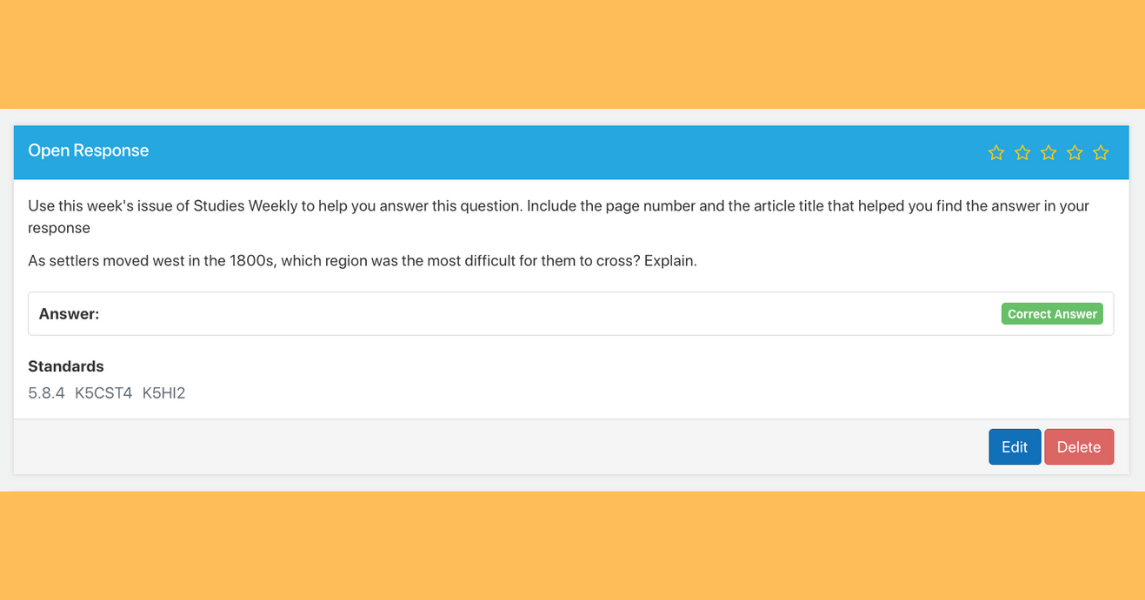Using Rubrics to Grade Open-Ended Questions
Mathematics is a straightforward subject. Students know the expectations they must meet to get a good grade: show their work, and make sure their numbers add up to the right answer.
Social studies and language arts are not as cut and dry, though. History, especially, is open to debate and opinion. Students often show their understanding through successful critical thinking and reasoning.
Great social studies and language arts teachers understand that open-ended assessment questions can have multiple correct answers, as long as they are supported with evidence. But some teachers struggle with how to grade these.
Creating Rubrics
To help with this conundrum, many language arts and social studies teachers use rubrics for open-ended questions, writing responses, essays, and even projects.
An effectively-designed rubric is an excellent tool that can 1) tell students what they need to do to succeed, 2) give them feedback on their skills and performance, while also 3) marking the response for completion and competency.
Successful rubrics are also clear, concise and calibrated. According to Kelly Roell at the education website, ThoughtCo, good rubrics include a well-defined learning goal.
“Before you can create a rubric, you need to decide the type of rubric you’d like to use, and that will largely be determined by your goals for the assessment,” Roell said in her July 2019 ThoughtCo article.
Teachers can define those goals by pondering what expectations they have for their students, feedback students need, what tasks students need to complete, and what standards or skills they must display.
These standards should be measurable, Roell added. She cautioned teachers to avoid too many criteria within the rubric.
“[Y]ou’ll need to brainstorm a list of knowledge and skills you would like to assess for the project. Group them according to similarities and get rid of anything that is not absolutely critical. A rubric with too much criteria is difficult to use!” she explained. “You’ll want to be able to spot the criteria quickly while grading and be able to explain them quickly when instructing your students.”
Janelle Cox pointed out in another 2019 ThoughtCo article that teachers should focus their rubric criteria descriptions on specific action verbs or phrases related to what students must do.
“The description must detail the features of a successful performance — what each student should be able to do, show, or otherwise apply following a lesson or unit,” she said, cautioning against using language describing what the student did not do. “The description should be as specific and detailed as possible to leave no room for uncertainty when analyzing student work. A teacher should be able to hold a student’s work against this description and immediately determine how effective their performance was.”
Teachers can find multiple rubric templates online or in their Teacher Editions to use in any grade. With a little customization, these examples can help teachers formulate rubrics that work for any type of open-ended question or assessment. The website, Teachers Pay Teachers, also has many free templates to help elementary teachers implement rubrics in their classroom.
Rubrics work with Studies Weekly assessments as well. A rubric for questions that require students to share and support their opinion, could look like this:

Using this rubric, teachers can then assign points or a grade to students’ open-ended question responses in Studies Weekly’s print or online assessments.
Teaching with Rubrics
Jeannette Balantic and Erica Fregosi shared a great example of using a clearly-defined rubric in their 2012 article for Social Studies and the Young Learner. They created the TEES Template to help their students strengthen their thinking, reasoning, and responses to open-ended assessments.
T = Stands for a solid topic sentence that introduces the main idea of the response.
E = Stands for evidence that supports the main idea or assertion.
E = Stands for expansion. Students should include specific details that explain how or why something happened, and how the evidence connects with the topic.
S = Stands for a summary that ties all of the information together.
Leading up to students’ TEES response, Balantic and Fregosi used additional handouts that asked students to think about how specific people or things affected history. The students went beyond learning historical facts — instead they used these facts to form arguments and support.
Balantic and Fregosi used pre-writing handouts that included graphic organizers to help students form and shape their reasoning and evidence. This is an essential part of using rubrics: sharing the rubric with students beforehand, so they know what goal to work towards, and teaching to the skills required.
